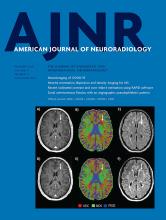Index by author
Annapragada, A.
- PediatricsOpen AccessDesign of 3D-Printed Nasopharyngeal Swabs for Children is Enabled by Radiologic ImagingZ. Starosolski, P. Admane, J. Dunn, B. Kaziny, T.A.G.M. Huisman and A. AnnapragadaAmerican Journal of Neuroradiology December 2020, 41 (12) 2345-2347; DOI: https://doi.org/10.3174/ajnr.A6794
Arthur, A.
- InterventionalYou have accessConsiderations for Antiplatelet Management of Carotid Stenting in the Setting of Mechanical Thrombectomy: A Delphi Consensus StatementM. Goyal, S. Yoshimura, G. Milot, J. Fiehler, M. Jayaraman, F. Dorn, A. Taylor, J. Liu, F. Albuquerque, M.E. Jensen, R. Nogueira, J.F. Fraser, R. Chapot, L. Thibault, C. Majoie, P. Yang, N. Sakai, D. Kallmes, K. Orlov, A. Arthur, P. Brouwer and J.M. OspelAmerican Journal of Neuroradiology December 2020, 41 (12) 2274-2279; DOI: https://doi.org/10.3174/ajnr.A6888
Asteggiano, C.
- EDITOR'S CHOICEAdult BrainOpen AccessNeurite Orientation Dispersion and Density Imaging for Assessing Acute Inflammation and Lesion Evolution in MSS. Sacco, E. Caverzasi, N. Papinutto, C. Cordano, A. Bischof, T. Gundel, S. Cheng, C. Asteggiano, G. Kirkish, J. Mallott, W.A. Stern, S. Bastianello, R.M. Bove, J.M. Gelfand, D.S. Goodin, A.J. Green, E. Waubant, M.R. Wilson, S.S. Zamvil, B.A. Cree, S.L. Hauser, R.G. Henry, and and University of California, San Francisco MS-EPIC TeamAmerican Journal of Neuroradiology December 2020, 41 (12) 2219-2226; DOI: https://doi.org/10.3174/ajnr.A6862
Neurite orientation dispersion and density imaging (NODDI) assesses microstructural features of neurites contributing to diffusion imaging signals. Twenty-one subjects with MS underwent serial enhanced MRIs including NODDI, the key metrics of which are the neurite density and orientation dispersion index. Twenty-one age- and sex-matched healthy controls underwent unenhanced MR imaging with the same protocol. NODDI is a promising tool with the potential to detect acute MS inflammation. The observed heterogeneity among lesions may correspond to gradients in severity and clinical recovery after the acute phase.
Avignone, S.
- Adult BrainOpen AccessCOVID-19–Associated PRES–like Encephalopathy with Perivascular Gadolinium EnhancementG. Conte, S. Avignone, M. Carbonara, M. Meneri, F. Ortolano, C. Cinnante and F. TriulziAmerican Journal of Neuroradiology December 2020, 41 (12) 2206-2208; DOI: https://doi.org/10.3174/ajnr.A6762
Badat, N.
- Adult BrainOpen AccessUnusual Brain MRI Pattern in 2 Patients with COVID-19 Acute Respiratory Distress SyndromeS. Toledano-Massiah, N. Badat, A. Leberre, C. Bruel, A. Ray, S. Gerber, M. Zins and J. HodelAmerican Journal of Neuroradiology December 2020, 41 (12) 2204-2205; DOI: https://doi.org/10.3174/ajnr.A6817
Bae, Y.J.
- Head & NeckOpen AccessMRI-Based Assessment of the Pharyngeal Constrictor Muscle as a Predictor of Surgical Margin after Transoral Robotic Surgery in HPV-Positive Tonsillar CancerY.J. Kim, W.-J. Jeong, Y.J. Bae, H. Kim, B.S. Choi, Y.H. Jung, S.H. Baik, L. Sunwoo and J.H. KimAmerican Journal of Neuroradiology December 2020, 41 (12) 2320-2326; DOI: https://doi.org/10.3174/ajnr.A6806
Baik, S.H.
- Head & NeckOpen AccessMRI-Based Assessment of the Pharyngeal Constrictor Muscle as a Predictor of Surgical Margin after Transoral Robotic Surgery in HPV-Positive Tonsillar CancerY.J. Kim, W.-J. Jeong, Y.J. Bae, H. Kim, B.S. Choi, Y.H. Jung, S.H. Baik, L. Sunwoo and J.H. KimAmerican Journal of Neuroradiology December 2020, 41 (12) 2320-2326; DOI: https://doi.org/10.3174/ajnr.A6806
Barkhof, F.
- Adult BrainOpen AccessNAA is a Marker of Disability in Secondary-Progressive MS: A Proton MR Spectroscopic Imaging StudyB.S. Solanky, N.A. John, F. DeAngelis, J. Stutters, F. Prados, T. Schneider, R.A. Parker, C.J. Weir, A. Monteverdi, D. Plantone, A. Doshi, D. MacManus, I. Marshall, F. Barkhof, C.A.M. Gandini Wheeler-Kingshott, J. Chataway and for the MS-SMART InvestigatorsAmerican Journal of Neuroradiology December 2020, 41 (12) 2209-2218; DOI: https://doi.org/10.3174/ajnr.A6809
Bastianello, S.
- EDITOR'S CHOICEAdult BrainOpen AccessNeurite Orientation Dispersion and Density Imaging for Assessing Acute Inflammation and Lesion Evolution in MSS. Sacco, E. Caverzasi, N. Papinutto, C. Cordano, A. Bischof, T. Gundel, S. Cheng, C. Asteggiano, G. Kirkish, J. Mallott, W.A. Stern, S. Bastianello, R.M. Bove, J.M. Gelfand, D.S. Goodin, A.J. Green, E. Waubant, M.R. Wilson, S.S. Zamvil, B.A. Cree, S.L. Hauser, R.G. Henry, and and University of California, San Francisco MS-EPIC TeamAmerican Journal of Neuroradiology December 2020, 41 (12) 2219-2226; DOI: https://doi.org/10.3174/ajnr.A6862
Neurite orientation dispersion and density imaging (NODDI) assesses microstructural features of neurites contributing to diffusion imaging signals. Twenty-one subjects with MS underwent serial enhanced MRIs including NODDI, the key metrics of which are the neurite density and orientation dispersion index. Twenty-one age- and sex-matched healthy controls underwent unenhanced MR imaging with the same protocol. NODDI is a promising tool with the potential to detect acute MS inflammation. The observed heterogeneity among lesions may correspond to gradients in severity and clinical recovery after the acute phase.
Bayrlee, A.
- FELLOWS' JOURNAL CLUBInterventionalOpen AccessCharacteristics of Large-Vessel Occlusion Associated with COVID-19 and Ischemic StrokeS. John, P. Kesav, V.A. Mifsud, B. Piechowski-Jozwiak, J. Dibu, A. Bayrlee, H. Elkambergy, F. Roser, M.S. Elhammady, K. Zahra and S.I. HussainAmerican Journal of Neuroradiology December 2020, 41 (12) 2263-2268; DOI: https://doi.org/10.3174/ajnr.A6799
Consecutive ischemic stroke and TIA admissions (COVID and non-COVID) to the authors' hospital during a 10-week period from March 1 to May 10, 2020 were collected and compared with data from the same time period in 2019. Among 20 patients with COVID-19 and acute ischemic stroke, 15 (75%) had large-vessel occlusion. These patients were young (mean age, 46.5 years), male (93%), without major burden of traditional cardiovascular risk factors, and had a severe stroke presentation. Large vessel occlusions were observed in multiple vessels (40%), uncommonly affected vessels, and atypical locations with a large thrombus burden.








